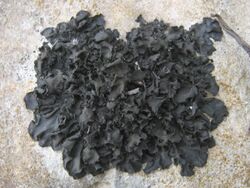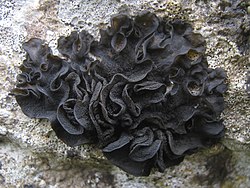Biology:Collema
| Collema | |
|---|---|

| |
| Collema flaccidum | |
| Scientific classification | |
| Domain: | Eukaryota |
| Kingdom: | Fungi |
| Division: | Ascomycota |
| Class: | Lecanoromycetes |
| Order: | Peltigerales |
| Family: | Collemataceae |
| Genus: | Collema Weber ex F.H.Wigg. (1780) |
| Type species | |
| Collema lactuca (Weber) Weber ex F.H.Wigg. (1780)
| |
| Synonyms[1] | |
|
List
| |
Collema (jelly lichen) is a genus of lichens in the family Collemataceae.[2] The photobiont is the cyanobacterium genus Nostoc.[3] Species in this genus typically grow on nutrient-rich bark or somewhat siliceous or calcareous rocks in humid environments.[4]
Description
Collema lichens are characterized by their medium to large size, with a diameter of 3 to 20 cm (1 to 8 in). They have a leaf-like, membranous structure that does not swell noticeably when wet. The upper surface of the thallus is dark olive-green to brown-black and is not hairy. The [[Glossary of lichen terms#{{biology:{1}}}|{{Biology:{1}}}]] are 2 to 15 mm broad, rounded, and usually flat or partially raised, with smooth or [[Glossary of lichen terms#{{biology:{1}}}|{{Biology:{1}}}]] surfaces adorned with elongated ridges or folds.[4]
Both upper and lower [[Glossary of lichen terms#{{biology:{1}}}|{{Biology:{1}}}]] are absent in Collema, and the photobiont Nostoc forms chains of cells throughout the thallus without creating a separate [[Glossary of lichen terms#{{biology:{1}}}|layer]]. Isidia can be present or absent, while soredia are not found in this genus. The reproductive structures, known as apothecia, have a pale brown to red-brown [[Glossary of lichen terms#{{biology:{1}}}|{{Biology:{1}}}]] that can be flat or convex. The [[Glossary of lichen terms#{{biology:{1}}}|{{Biology:{1}}}]] is whole and sometimes displays isidia.[4]
The [[Glossary of lichen terms#{{biology:{1}}}|{{Biology:{1}}}]] consists of cells that can be either uniformly sized or elongated. The [[Glossary of lichen terms#{{biology:{1}}}|{{Biology:{1}}}]] is indistinct and can be colourless or pigmented, while the hymenium is colorless and turns blue when treated with iodine. A more or less colourless [[Glossary of lichen terms#{{biology:{1}}}|{{Biology:{1}}}]] is also present. The [[Glossary of lichen terms#{{biology:{1}}}|{{Biology:{1}}}]] comprises paraphyses that separate in a solution of potassium hydroxide and may be unbranched or branched, often connecting near their tips, which can be club-shaped or round and exhibit a yellowish to reddish-brown hue.[4]
The asci are club-shaped (clavate) with a strongly thickened apex, and both the [[Glossary of lichen terms#{{biology:{1}}}|{{Biology:{1}}}]] and the downwardly projecting annulus and apical cap react blue to iodine. Each ascus produces eight spores that are narrowly ellipsoidal to spindle-shaped or nearly cylindrical with transverse septa. [[Glossary of lichen terms#{{biology:{1}}}|{{Biology:{1}}}]], or [[Glossary of lichen terms#{{biology:{1}}}|{{Biology:{1}}}]], are immersed within the thallus and can be located on the margins or lamina with a pale ostiole. The [[Glossary of lichen terms#{{biology:{1}}}|{{Biology:{1}}}]] are rod-shaped with a slightly enlarged apex. No lichen products have been detected in Collema using thin-layer chromatography.[4]
Species
(As of April 2023), Species Fungorum (in the Catalogue of Life) accepts 24 species of Collema.[2]


- Collema actinoptychum Nyl. (1868)[5]
- Collema coniophilum Goward (2009)[6] – Canada
- Collema flaccidum (Ach.) Ach. (1810)
- Collema furfuraceum (Schaer.) Du Rietz (1929)
- Collema glaucophthalmum Nyl. (1858)[7]
- Collema glebulentum (Nyl. ex Cromb.) Degel. (1952)
- Collema implicatum Nyl. (1863)[8]
- Collema insulare Degel. (1974)
- Collema japonicum (Müll.Arg.) Hue (1898)
- Collema laeve Hook.f. & Taylor (1844)
- Collema leptaleum Tuck. (1866)[9]
- Collema leucocarpum Hook.f. & Taylor (1844)
- Collema marginale (Huds.) Hoffm. (1794)
- Collema nigrescens (Huds.) DC. (1805)
- Collema pulcellum Ach. (1814)
- Collema pustulatum Ach. (1814)
- Collema rugosum Kremp. (1870)
- Collema ryssoleum (Tuck.) A.Schneid. (1872)
- Collema sichuanense H.J.Liu & J.C.Wei (2003))[10] – China
- Collema subconveniens Nyl. (1888)
- Collema subflaccidum Degel. (1974)[11]
- Collema subnigrescens Degel. (1954)[12]
- Collema substipitatum Zahlbr. (1930)
References
- ↑ "Synonymy: Collema Weber ex F.H. Wigg., Prim. fl. holsat. (Kiliae): 89 (1780)". Species Fungorum. http://www.speciesfungorum.org/Names/SynSpecies.asp?RecordID=1175.
- ↑ 2.0 2.1 "Collema". Species 2000: Naturalis, Leiden, the Netherlands. https://www.catalogueoflife.org/data/taxon/3SBC.
- ↑ Dobson, F.S. (2000) Lichens, an illustrated guide to the British and Irish species. 4th edition. Richmond publishing Co., Slough, England.
- ↑ 4.0 4.1 4.2 4.3 4.4 Cannon, Paul; Otálora, Mónica A.G.; Košuthová, Alica; Wedin, Mats; Aptroot, André; Coppins, Brian; Simkin, Janet (2020). "Peltigerales: Collemataceae, including the genera Blennothallia, Callome, Collema, Enchylium, Epiphloea, Lathagrium, Leptogium, Pseudoleptogium, Rostania and Scytinium". Revisions of British and Irish Lichens 2: 1–38 [12]. doi:10.34885/174.

- ↑ Nylander, W. (1867). "Synopsis lichenum Novae Caledoniae" (in la). Bulletin de la Société Linnéenne de Normandie. 2 (2): 39–140 [43]. https://www.biodiversitylibrary.org/page/9711876.
- ↑ Spribille, Toby; Björk, Curtis R.; Ekman, Stefan; Elix, John A.; Goward, Trevor; Printzen, Christian; Tønsberg, Tor; Wheeler, Tim (2009). "Contributions to an epiphytic lichen flora of northwest North America: I. Eight new species from British Columbia inland rain forests". The Bryologist 112 (1): 109–137. doi:10.1639/0007-2745-112.1.109.
- ↑ Nylander, W. (1858). "Lichenes collecti in Mexico a Fr. Müller" (in la). Flora (Regensburg) 41: 377–386. https://www.biodiversitylibrary.org/page/51418.
- ↑ Nylander, W. (1863). "Lichenographia Novogranatensis prodromus" (in la). Acta Societatis Scientiarum Fennicae 7 (2): 415–504. https://www.biodiversitylibrary.org/page/13599173.
- ↑ Tuckerman, E. (1864). "Observations on North American and other lichens". Proceedings of the American Academy of Arts and Sciences 6: 263–287. https://www.biodiversitylibrary.org/page/3097429.
- ↑ Liu, H.J.; Wei, J.C. (2003). "Two new taxa of the lichen genus Collema from China". Mycosystema 22 (4): 531–533.
- ↑ Degelius, G. (1974). The lichen genus Collema with special reference to the extra-European species. Symbolae Botanicae Upsalienses. 20. p. 140.
- ↑ Degelius, G. (1954). The lichen genus Collema in Europe. Symbolae Botanicae Upsalienses. 13. p. 413.
Wikidata ☰ Q150980 entry
 |

